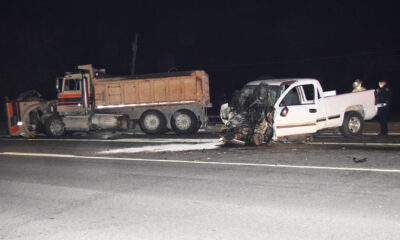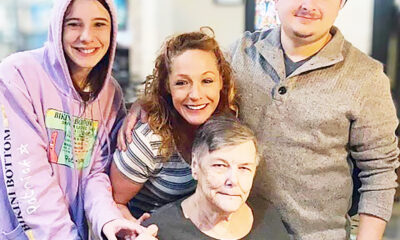COUNTY LIFE
Red Cross tips for a safe July 4th holiday

As we get ready to celebrate Independence Day, many of us plan to attend fireworks displays, a backyard picnic, or perhaps enjoy fun in the water at a waterpark, beach or pool. The American Red Cross wants you to enjoy a fun-packed, safe holiday and offers these tips you can follow over the upcoming holiday:
FIREWORKS SAFETY
The safest way to enjoy fireworks is to attend a public firework show put on by professionals. Stay at least 500 feet away from the show. Many states outlaw most fireworks. Leave any area immediately where untrained amateurs are using fireworks. If you are setting fireworks off at home, follow these safety steps:
1. Never give fireworks to small children, and never throw or point a firework toward people, animals, vehicles, structures or flammable materials. Always follow the instructions on the packaging.
2. Keep a supply of water close by as a precaution.
3. Make sure the person lighting fireworks always wears eye protection.
4. Light only one firework at a time and never attempt to relight “a dud.”
5. Store fireworks in a cool, dry place away from children and pets.
PICNIC SAFETY
1. Don’t leave food out in the hot sun. Keep perishable foods in a cooler with plenty of ice or freezer gel packs.
2. Wash your hands before preparing the food.
3. If you are going to cook on a grill, always supervise the grill when in use. Don’t add charcoal starter fluid when coals have already been ignited. Use the long-handled tools especially made for cooking on the grill to keep the chef safe.
4. Never grill indoors. Keep the grill out in the open, away from the house, the deck, tree branches, or anything that could catch fire.
5. Make sure everyone, including pets, stays away from the grill.
WATER SAFETY
Children and adults should learn to swim so they at least achieve the skills of water competency: be able to enter the water, get a breath, stay afloat, change position, swim a distance and then get out of the water safely. Watch the weather and get out of the water at the first sign of lightning or the rumble of thunder. Stay indoors and away from water for 30 minutes after the last lightning flashes or thunder roars. Plan ahead for aquatic activities:
1. Provide close and constant attention to children you are supervising in or near water
2. Fence pools and spas with adequate barriers, including four-sided fencing
3. Learn swimming and water survival skills
4. Children, inexperienced swimmers, and all boaters should wear properly fitted U.S. Coast Guard-approved life jackets;
5. Always swim in a lifeguarded area.
BEACH SAFETY
1. If you plan to swim in the ocean, a lake or river, be aware that swimming in these environments is different than swimming in a pool. Be sure you have the skills for these environments.
2. Swim only at a beach with a lifeguard, within the designated swimming area. Obey all instructions and orders from lifeguards and ask them about local conditions.
3. Make sure you swim sober and that you always swim with a buddy. Know your limitations and make sure you have enough energy to swim back to shore.
4. Protect your neck – don’t dive headfirst. Walk carefully into open waters. Watch out for and avoid aquatic life.
5. If you are caught in a rip current, try not to panic. Signal to those on shore that you need assistance. Swim parallel to the shore until you are out of the current. Once you are free, swim toward shore. If you can’t swim to the shore, float or tread water until you are free of the rip current and then head toward shore.
WATER PARK SAFETY
1. Make sure lifeguards are on duty before you go in the water and follow all their instructions.
2. Wear protective clothing, including a hat and some kind of cover-up for when you’ve had enough sun. Use sunscreen before leaving home and reapply during the day.
3. Parents – keep an eye on the kids. If they can’t swim or are less than four feet tall, have them wear a U.S. Coast Guard approved life jacket.
4. Signal a lifeguard if you see someone is in trouble. Yell if you need to grab attention, but don’t go in after the person yourself.
5. Set up a meeting place in case someone gets separated from your group. Use the buddy system to make sure no child is alone.
About the American Red Cross:
The American Red Cross shelters, feeds and provides emotional support to victims of disasters; supplies about 40 percent of the nation’s blood; teaches skills that save lives; provides international humanitarian aid; and supports military members and their families. The Red Cross is a not-for-profit organization that depends on volunteers and the generosity of the American public to perform its mission. For more information, please visit redcross.org or cruzrojaamericana.org, or visit us on Twitter at @RedCross.
COUNTY LIFE
Free Music in the Park Festival on June 14

Make plans to enjoy a leisure Saturday in the park at the Music in the Park Festival on June 14 in Bowie’s Pelham Park.
Guests are invited to bring their lawn chairs and set up under the oak trees that fill the park near the amphitheater. This is the second year for this free festival as it expands to a full day hosted by the Bowie Community Center and R&K Sound Company.
The day opens with a 5K run/walk at 8:30 a.m. at the Pelham Park Pavillion. Pre-race warm-up begins at 8:10 a.m. and the race starts at 8:30 a.m. There will be first-third place winners in each age category.
Entry fee is $35 and participants receive a T-shirt. A portion of the proceeds will benefit the Clear Choice Pregnancy Resource Center. Enter at the QR code on the Clear Choice Facebook page or email fourseasonsraceseries@gmail.com.
Live accoustic music opens the free festival starting at 11:30 a.m. with Corbin Woolsey, Blake Mangus, Tiffany Chandler, Sara White and Dillon Edwards. Other live music that day will include Bad Daddy Band and Bricktown Band. ZZ Texas, a ZZ Top tribute band will take the stage at 8 p.m. Live music continues until 10 p.m.
There will be food truck vendors, bounce houses (fee) and vendors. Guests are allowed to bring beer in a cooler, but no soda pop or similar drinks. There will be a $5 cooler fee.
Those with questions may call Bonnie at 940-872-4861 or Kenny at 817-704-9847.
COUNTY LIFE
Nocona Chamber presents annual awards

By BARBARA GREEN
editor@bowienewsonline.com
Members of the Nocona Chamber of Commerce celebrated their past year during the annual awards banquet Monday night surrounded by theme of “Roaring ‘20s.”
A beautiful array of tables welcomed guests to the annual event in the H.J. Justin Building in downtown Nocona. Longtime chamber member and local businessman Larry Lemons welcomed the group and shared his tale of the benefits of being in the chamber of commerce in humorous verse.
“If you love seeing deliberate strides in your community,” you may want to be a chamber member. He pointed to the chamber’s efforts to promote the town, welcome visitors and promote business members.
Hobie Meekins of Wells Fargo Bank was named Chamber Citizen of the Year.
Read the full story and see more photos in the Thursday Bowie News.
Top photo: The Carpenter Shop was named Organization of the Year by the Nocona Chamber of Commerce.

COUNTY LIFE
Cruisin’ Nocona opens Friday

For the 12th year in a row Nocona celebrates the automobile with Cruisin’ Nocona on June 6-7 with a slate of events across downtown.
This event, hosted by the Nocona Chamber of Commerce, made the move from May to June in 2025, but the activities remain the same.
The festivities kick off Friday morning with registration and check-in from 8:30 to 10:30 a.m. at the H.J. Justin Building, 100 Clay Street. That will be followed by a breakfast burrito fundraiser (by donation) benefiting Nocona Lucky Paws from 9 to 10 a.m. It is open to everyone, even those not participating in the cruise.
Chamber organizers explained due to state regulations the cruise can no longer be called a “poker run,” but it will contain a “game component” that will have the same spirit of fun as prior events as everyone enjoys the spring countryside. There will be case prizes of $200, $100 and $50 for first, second and third places.
At 11 a.m. the cruise and game begin, followed by a barbecue lunch at 1 p.m. prepared by the Nocona High School BBQ Team, also at the Justin Building. The cruise resumes at 2:20 p.m. and concludes at Nocona Beer at the Brewery by 4:15 p.m., with game winners announced at 4:30 p.m.
The evening wraps up with the Dark of the Moon Lighted Truck Convoy at 8:30 p.m., traveling down Clay Street and back to the brewery.
June 7 begins with a pancake breakfast from 8 to 10 a.m. at the Justin Building, featuring pancakes, sausage, fruit, coffee, and orange juice. The breakfast is by donation and open to anyone in the community, benefiting American Legion Riders Chapter 220.
At 10 a.m. registration opens for the Car, Motorcycle, and Working Truck Show, with judging beginning at 1 p.m. Kids can join the fun during the Power Wheels Races at 2 p.m. (vehicles must be unmodified and child-operated). The awards ceremony begins at 4 p.m. followed by a live concert by Tin Rivers.
Additional highlights on Saturday include local vendors, food trucks, shopping, and the Trucking Thru Time Rolling Truck Museum, making this a full day of fun for all ages.
-

 NEWS3 years ago
NEWS3 years ago2 hurt, 1 jailed after shooting incident north of Nocona
-

 NEWS2 years ago
NEWS2 years agoSuspect indicted, jailed in Tia Hutson murder
-

 NEWS2 years ago
NEWS2 years agoSO investigating possible murder/suicide
-

 NEWS2 years ago
NEWS2 years agoWreck takes the life of BHS teen, 16
-

 NEWS2 years ago
NEWS2 years agoMurder unsolved – 1 year later Tia Hutson’s family angry, frustrated with no arrest
-

 NEWS2 years ago
NEWS2 years agoSheriff’s office called out to infant’s death
-

 NEWS2 years ago
NEWS2 years agoBowie Police face three-hour standoff after possible domestic fight
-

 NEWS3 years ago
NEWS3 years agoDriver stopped by a man running into the street, robbed at knifepoint






